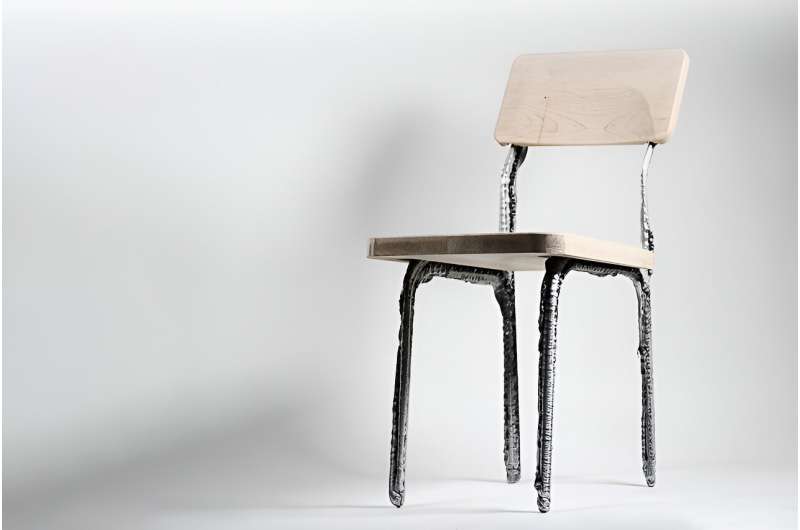
MIT researchers have developed an additive manufacturing technique that can print rapidly with liquid metal, producing large-scale parts such as table legs and chair frames in a matter of minutes.
Their technique, called liquid metal printing (LMP), involves depositing molten aluminum along a predefined path into a bed of tiny glass beads. The aluminum quickly hardens into a 3D structure.
The researchers say LMP is at least 10 times faster than a comparable metal additive manufacturing process, and the procedure to heat and melt the metal is more efficient than some other methods.
The technique does sacrifice resolution for speed and scale. While it can print components that are larger than those typically made with slower additive techniques, and at a lower cost, it cannot achieve high resolutions.
For instance, parts produced with LMP would be suitable for some applications in architecture, construction, and industrial design, where components of larger structures often don't require extremely fine details. It could also be utilized effectively for rapid prototyping with recycled or scrap metal.
In a recent study, the researchers demonstrated the procedure by printing aluminum frames and parts for tables and chairs which were strong enough to withstand postprint machining. They showed how components made with LMP could be combined with high-resolution processes and additional materials to create functional furniture.
"This is a completely different direction in how we think about metal manufacturing that has some huge advantages. It has downsides, too. But most of our built world—the things around us like tables, chairs, and buildings—doesn't need extremely high resolution.
"Speed and scale, and also repeatability and energy consumption, are all important metrics," says Skylar Tibbits, associate professor in the Department of Architecture and co-director of the Self-Assembly Lab, who is senior author of a paper introducing LMP.
Tibbits is joined on the paper by lead author Zain Karsan SM '23, who is now a Ph.D. student at ETH Zurich; as well as Kimball Kaiser SM '22 and Jared Laucks, a research scientist and lab co-director. The research was presented at the Association for Computer Aided Design in Architecture Conference and recently published in the association's proceedings.
Significant speedup
One method for printing with metals that is common in construction and architecture, called wire arc additive manufacturing (WAAM), is able to produce large, low-resolution structures, but these can be susceptible to cracking and warping because some portions must be remelted during the printing process.
LMP, on the other hand, keeps the material molten throughout the process, avoiding some of the structural issues caused by remelting.
Drawing on the group's previous work on rapid liquid printing with rubber, the researchers built a machine that melts aluminum, holds the molten metal, and deposits it through a nozzle at high speeds. Large-scale parts can be printed in just a few seconds, and then the molten aluminum cools in several minutes.
"Our process rate is really high, but it is also very difficult to control. It is more or less like opening a faucet. You have a big volume of material to melt, which takes some time, but once you get that to melt, it is just like opening a tap. That enables us to print these geometries very quickly," Karsan explains.
The team chose aluminum because it is commonly used in construction and can be recycled cheaply and efficiently.
Bread loaf-sized pieces of aluminum are deposited into an electric furnace, "which is basically like a scaled-up toaster," Karsan adds. Metal coils inside the furnace heat the metal to 700°C, slightly above aluminum's 660° melting point.
The aluminum is held at a high temperature in a graphite crucible, and then molten material is gravity-fed through a ceramic nozzle into a print bed along a preset path. They found that the larger the amount of aluminum they could melt, the faster the printer can go.
"Molten aluminum will destroy just about everything in its path. We started with stainless steel nozzles and then moved to titanium before we ended up with ceramic. But even ceramic nozzles can clog because the heating is not always entirely uniform in the nozzle tip," Karsan says.
By injecting the molten material directly into a granular substance, the researchers don't need to print supports to hold the aluminum structure as it takes shape.
More information: Paper: Liquid Metal Printing
This story is republished courtesy of MIT News (web.mit.edu/newsoffice/), a popular site that covers news about MIT research, innovation and teaching.
Citation: Researchers demonstrate rapid 3D printing with liquid metal (2024, January 25) retrieved 25 January 2024 from https://techxplore.com/news/2024-01-rapid-3d-liquid-metal.html
This document is subject to copyright. Apart from any fair dealing for the purpose of private study or research, no part may be reproduced without the written permission. The content is provided for information purposes only.
